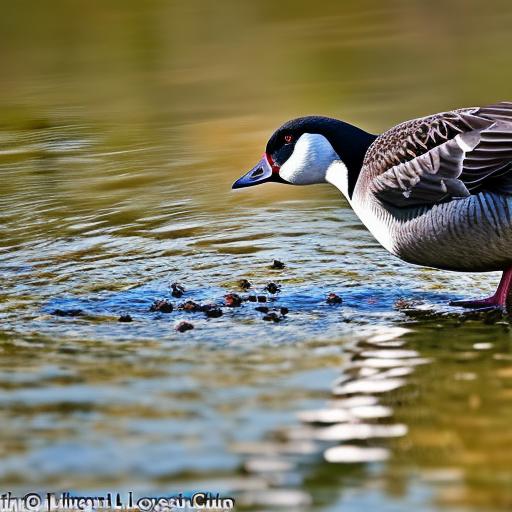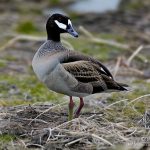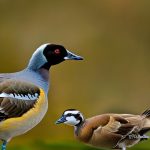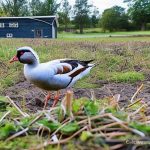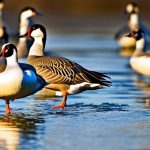Canadian geese are a common sight in many areas of North America, but their presence can often become a nuisance for property owners. These large birds can cause damage to lawns, gardens, and other landscaping features, as well as leave behind droppings that can be unsightly and unsanitary. In order to effectively manage the presence of Canadian geese on properties, it is important to implement strategies that deter them from nesting and feeding in these areas. This article will explore various management strategies that can be used to keep geese off your property and maintain a clean and safe environment.
Key Takeaways
- Canadian geese are attracted to open water and grassy areas for nesting and feeding.
- Physical barriers such as fences and netting can be effective in deterring geese from entering certain areas.
- Sound and visual deterrents such as decoys and noise-making devices can also be used to keep geese away.
- Creating a natural habitat that includes tall grasses and shrubs can discourage geese from nesting on your property.
- Properly managing water sources by reducing access and adding deterrents can also discourage geese from staying.
Understanding the behavior of Canadian geese
In order to effectively manage Canadian geese, it is important to understand their habits and behaviors. These birds are highly adaptable and can thrive in a variety of environments, which makes them difficult to deter. Canadian geese are known for their strong homing instincts, which means that once they find a suitable nesting or feeding area, they are likely to return year after year. They are also social animals that prefer to congregate in large groups, which can make it challenging to keep them off your property.
Understanding the behavior of Canadian geese is crucial because it allows property owners to implement management strategies that specifically target these behaviors. For example, knowing that geese prefer open areas with easy access to water can help property owners design their landscaping in a way that discourages nesting and feeding. By understanding the habits and behaviors of Canadian geese, property owners can develop effective management strategies that address the specific needs of these birds.
Implementing physical barriers to deter geese
One effective strategy for keeping geese off your property is the use of physical barriers. Fences, netting, and hedges can all be used to create boundaries that prevent geese from accessing certain areas. When choosing a physical barrier, it is important to consider the height and durability of the structure. Canadian geese are capable of flying, so a fence or netting that is too low may not be effective. Additionally, the barrier should be sturdy enough to withstand the weight of the birds and any attempts they may make to break through.
Installing physical barriers can be a time-consuming and costly process, but it can be an effective long-term solution for keeping geese off your property. It is important to regularly inspect and maintain these barriers to ensure that they remain intact and functional. Additionally, property owners should consider the aesthetics of the barriers and how they will fit into the overall design of the property.
Using sound and visual deterrents to keep geese away
In addition to physical barriers, sound and visual deterrents can also be effective in deterring geese from your property. Scarecrows, reflective tape, and predator decoys are all examples of visual deterrents that can be used to create a sense of danger and discourage geese from nesting or feeding in certain areas. These visual deterrents should be placed strategically throughout the property to maximize their effectiveness.
Sound deterrents, such as noise-making devices or recordings of predator calls, can also be used to keep geese away. These devices emit loud noises or play recordings that mimic the sounds of predators, which can scare geese away. It is important to regularly change the location of these devices to prevent geese from becoming accustomed to the sounds.
When using sound and visual deterrents, it is important to choose options that are safe for both humans and wildlife. Some deterrents may be harmful or disruptive to other animals or humans in the area, so it is important to carefully consider the potential impacts before implementing these strategies.
Creating a natural habitat that discourages geese from nesting
Creating a natural habitat that is less attractive to geese for nesting and feeding can also be an effective management strategy. Canadian geese prefer open areas with easy access to water, so property owners can design their landscaping in a way that discourages these birds from nesting and feeding. This can be done by planting tall grasses or shrubs that provide cover and make it difficult for geese to access the area.
Additionally, property owners can create barriers around water sources, such as ponds or lakes, to prevent geese from congregating. This can be done by planting vegetation around the edges of the water or installing floating barriers that make it difficult for geese to access the area.
It is important to regularly maintain the landscaping and habitat features to ensure that they remain effective in deterring geese. This may involve trimming or removing vegetation that becomes overgrown or installing additional barriers as needed.
Properly managing water sources to discourage geese
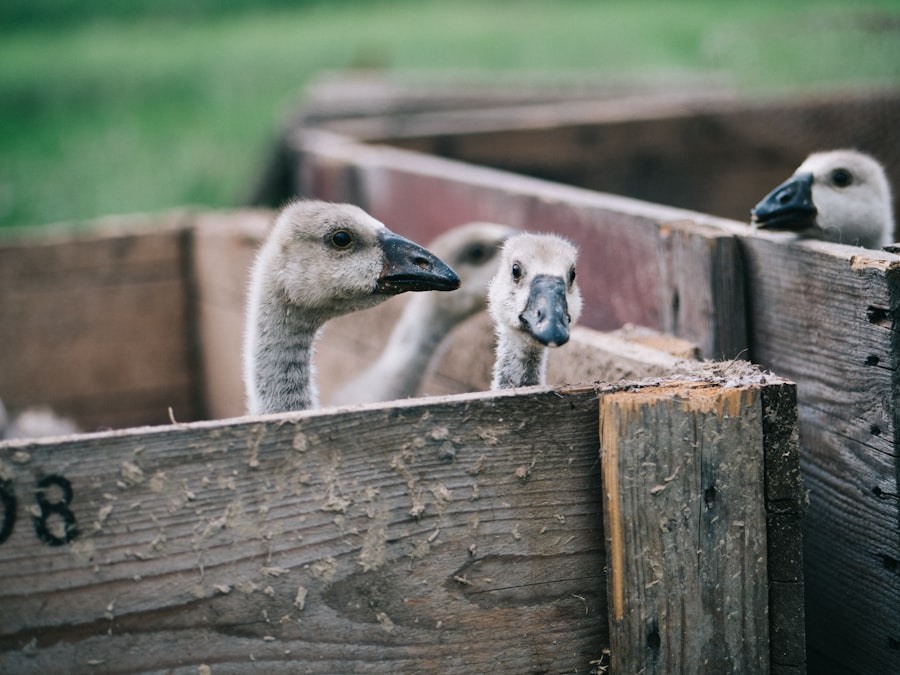
Water sources, such as ponds or lakes, are often attractive to Canadian geese because they provide easy access to food and a place to rest. In order to discourage geese from congregating in these areas, it is important to properly manage the water sources on your property.
One effective strategy is to install a fountain or aerator in the water source. The movement of the water can make it less appealing for geese to swim or feed in the area. Additionally, property owners can install floating barriers or netting on the surface of the water to prevent geese from accessing it.
Regular maintenance of the water source is also important. This may involve removing any debris or vegetation that accumulates in the water, as well as regularly inspecting and repairing any equipment that is used to manage the water source.
Implementing landscaping techniques to deter geese
In addition to creating a natural habitat that discourages geese from nesting, property owners can also implement specific landscaping techniques to deter these birds. For example, planting certain types of vegetation can make an area less attractive for geese to feed or nest.
Tall grasses, such as switchgrass or big bluestem, can provide cover and make it difficult for geese to access an area. Additionally, planting shrubs or trees that have thorny or prickly foliage can deter geese from landing or nesting in these areas.
It is important to regularly maintain the landscaping features to ensure that they remain effective in deterring geese. This may involve trimming or removing vegetation that becomes overgrown or installing additional barriers as needed.
Utilizing repellents and deterrent sprays
Repellents and deterrent sprays can also be effective in keeping geese away from your property. These products are typically applied to areas where geese are likely to feed or nest, such as lawns or gardens. The repellents emit a scent or taste that is unpleasant to geese, which deters them from accessing the area.
When choosing a repellent or deterrent spray, it is important to consider the safety and effectiveness of the product. Some products may be harmful to other animals or humans in the area, so it is important to carefully read and follow the instructions before applying them.
It is also important to regularly reapply the repellent or deterrent spray, as rain or other weather conditions can wash it away. Additionally, property owners should consider the potential impacts of these products on the environment and choose options that are safe for both wildlife and humans.
Establishing a routine maintenance plan to keep geese off your property
Regular maintenance is crucial for keeping geese off your property. This involves regularly inspecting and repairing physical barriers, sound and visual deterrents, landscaping features, and water sources. It also includes regularly reapplying repellents and deterrent sprays as needed.
Establishing a routine maintenance plan can help ensure that these management strategies remain effective in deterring geese. This may involve scheduling regular inspections and maintenance tasks, as well as keeping track of any changes or improvements that need to be made.
Seeking professional help for geese control
While many property owners are able to effectively manage geese on their own, there may be situations where professional help is needed. Professional geese control services have the knowledge and experience to implement effective management strategies and can provide guidance and support throughout the process.
When choosing a professional geese control service, it is important to consider their experience and expertise in managing geese. Property owners should also inquire about the methods and products that will be used, as well as any potential impacts on the environment or other wildlife.
Understanding local laws and regulations regarding geese management
It is important to understand and comply with local laws and regulations regarding geese management. Some areas may have specific guidelines or restrictions on the methods that can be used to deter geese, so property owners should familiarize themselves with these regulations before implementing any management strategies.
Additionally, property owners should consider the potential impacts of their management strategies on other wildlife or humans in the area. It is important to choose options that are safe and environmentally friendly.
Managing Canadian geese on your property can be a challenging task, but with the right strategies and techniques, it is possible to keep these birds away and maintain a clean and safe environment. By understanding the behavior of Canadian geese and implementing physical barriers, sound and visual deterrents, landscaping techniques, and repellents, property owners can effectively deter geese from nesting and feeding on their properties. Regular maintenance and compliance with local laws and regulations are also crucial for long-term success. By taking action to manage geese on their properties, property owners can create a more enjoyable and inviting space for themselves and their communities.
If you’re looking for effective ways to keep Canadian geese off your property, you might also be interested in learning how to convert a shed into a chicken coop. This informative article from Poultry Wizard provides step-by-step instructions on transforming a shed into a safe and comfortable space for your chickens. By implementing the tips and techniques mentioned in this article, you can create a secure environment that not only keeps your chickens happy but also deters unwanted visitors like Canadian geese.
FAQs
What are Canadian geese?
Canadian geese, also known as Canada geese, are large waterfowl native to North America. They are known for their distinctive black heads and necks, white cheek patches, and honking calls.
Why do Canadian geese come onto my property?
Canadian geese are attracted to properties with bodies of water, open grassy areas, and food sources such as grass, grains, and insects. They may also be seeking shelter or nesting sites.
How can Canadian geese be harmful to my property?
Canadian geese can cause damage to lawns, gardens, and crops by grazing on vegetation. Their droppings can also create unsanitary conditions, as they can carry bacteria and parasites that may be harmful to humans and pets.
What are some humane ways to keep Canadian geese off my property?
Some humane ways to deter Canadian geese from your property include installing fencing, using visual deterrents like scarecrows or reflective tape, planting vegetation that is unappealing to geese, and using noise-making devices.
Are there any laws protecting Canadian geese?
Yes, Canadian geese are protected under the Migratory Bird Treaty Act in the United States and the Migratory Birds Convention Act in Canada. It is illegal to harm, harass, or disturb Canadian geese without the proper permits.
Meet Walter, the feathered-friend fanatic of Florida! Nestled in the sunshine state, Walter struts through life with his feathered companions, clucking his way to happiness. With a coop that’s fancier than a five-star hotel, he’s the Don Juan of the chicken world. When he’s not teaching his hens to do the cha-cha, you’ll find him in a heated debate with his prized rooster, Sir Clucks-a-Lot. Walter’s poultry passion is no yolk; he’s the sunny-side-up guy you never knew you needed in your flock of friends!

